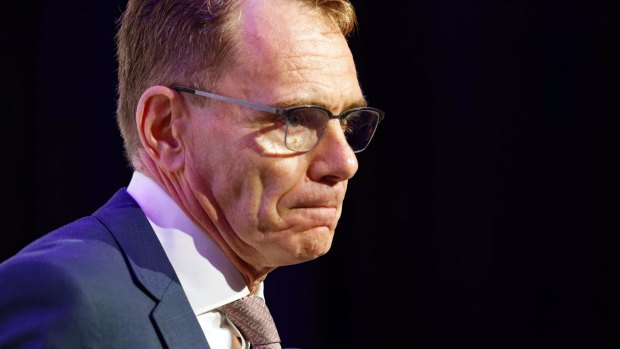- Analysis
- Business
- Companies
- Team building
This was published 6 years ago
BHP's executive leadership shuffle reveals a lot about its future
BHP’s shuffling of executives at the pointy end of its management structure provides an insight into its priorities and a glimpse into its future.
While two of the changes were effectively forced on Andrew Mackenzie by executives deciding of their own volition to move on, the choices he has made in remaking his executive leadership team signal his views on the most significant challenge confronting the group, and the most likely talent pool from which the successors to his successor will come.

BHP CEO Andrew Mackenzie: His choice of replacements and additions to his leadership team is revealing.Credit: Trevor Collens
One of the departures was obvious, after the $US10.8 billion sale of the group’s US onshore shale oil and gas business.
Steve Pastor, who headed up the BHP petroleum business, saw his portfolio greatly reduced and decided to move on, hoping to land a role in a business with greater scale.
With BHP’s unconventional petroleum assets gone, it was logical that its head of conventional petroleum assets, Geraldine Slattery, should take charge of a division that now has only conventional assets.
Less predictable is the departure of BHP’s chief commercial officer, Arnoud Balhuizen, after a 25-year career, initially with Billiton and subsequently, after the 2001 merger, with BHP.
Succession race
While his name had come up in succession discussions, he has been regarded as a less likely candidate than the two internal front-running candidates, chief financial officer Peter Beavan and Mike Henry, who has responsibility for the group’s Australian mining operations.
The other potential internal candidate is Danny Malchuk, who heads up the group’s North American mining operations.
Balhuizen will return home to the Netherlands after a career in which he has been credited with creating a global commercial team for BHP and integrating its marketing and supply functions. Within BHP, there is an expectation that he, like Pastor, will be looking for a chief executive role elsewhere.
It is Mackenzie’s choice of replacements, and additions, to his leadership team that is revealing.
Balhuizen’s role will be filled by Vandita Pant, currently group treasurer and head of BHP's European operations. She has a background in strategy and capital markets, having worked at ABN Amro and Royal Bank of Scotland.
Should Beaven win the contest to succeed Mackenzie, she is regarded as his natural successor as BHP’s finance chief.
Should he lose and, as is usually the case, depart the company in search of a CEO post, the outcome would be the same.
There are two additions, rather than replacements, to the leadership team, that point to long-term succession planning.
The most urgent challenge confronting Mackenzie and his team is to stop the run of unrelated incidents that have affected the mining giant's results in recent years.
Its December-half results were overwhelmed by the impact of the derailment of a train in its Pilbara operations, unplanned outages at Olympic Dam and fires at its Spence copper project in Chile and West Australian nickel operations.
They cost it almost $US500 million ($702.5 million) in lost productivity.
Until now, Mackenzie has been his own chief transformation officer, driving the focus on improving productivity.
In the hot seat
Jonathon Price, who has a background in investment banking but has spent 13 years within BHP in a wide variety of roles, was most recently titled "transformation director," reporting directly to Mackenzie. Now he has been appointed chief transformation officer, and will join the executive leadership team.
Laura Tyler, currently in charge of the forever-challenged Olympic Dam operation, has been appointed chief geoscientist and is the other addition to the executive leadership team.
Price is in the hot seat. He has been charged with ensuring BHP’s operations are more reliable and productive. Failures will be immediately visible to those outside BHP, but successes expected and taken for granted.
Internally, if he can deliver both an absence of unpleasant operational surprises and productivity gains, he’ll be in the frame, not for the next CEO contest but the subsequent one.
Tyler has an as yet unresolved challenge in remaking Olympic Dam as a reliable operation and a respectable contributor to earnings and returns on capital. At present, it is the lowest-returning of BHP’s operating assets but Tyler is close to finalising a $3 billion plan to dramatically increase its production.
The expansion of her role, given the scale of the existing challenge she is confronting – Olympic Dam has, throughout its long history, been plagued by operating issues and sub-economic returns – says how highly Mackenzie regards her.
She has a deep and technical background in mining and the addition of the chief geoscientist role to her existing responsibilities underscores her value as someone with real operational experience within the leadership team.
It also tends to indicate that Mackenzie is elevating exploration and the more technical and mining-specific aspects of risk management within BHP’s priorities. After the latest tailings dam disaster in Brazil, engineering and geological risks would obviously be front of mind.
Like Price, Tyler’s failures would be obvious -- and probably near career-ending -- but, if she can solve the conundrum of Olympic Dam and turn a fabulous resource into a mine that finally delivers respectable and consistent returns on capital, she’d join Price and Pant on the developing list of future BHP CEOs.